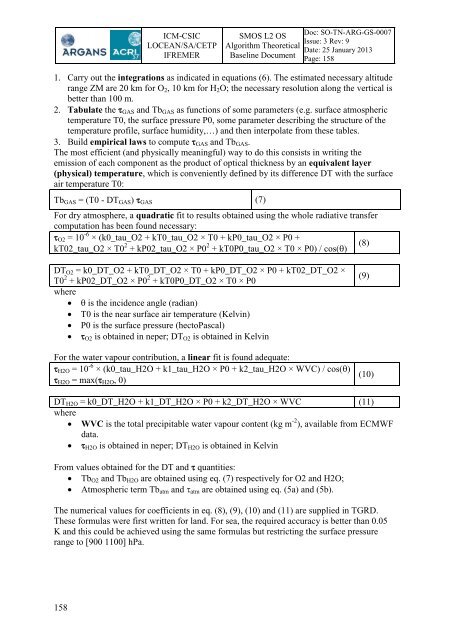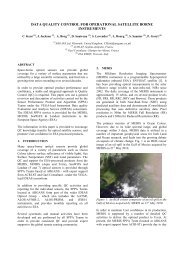SMOS L2 OS ATBD - ARGANS
SMOS L2 OS ATBD - ARGANS
SMOS L2 OS ATBD - ARGANS
Create successful ePaper yourself
Turn your PDF publications into a flip-book with our unique Google optimized e-Paper software.
158<br />
ICM-CSIC<br />
LOCEAN/SA/CETP<br />
IFREMER<br />
<strong>SM<strong>OS</strong></strong> <strong>L2</strong> <strong>OS</strong><br />
Algorithm Theoretical<br />
Baseline Document<br />
Doc: SO-TN-ARG-GS-0007<br />
Issue: 3 Rev: 9<br />
Date: 25 January 2013<br />
Page: 158<br />
1. Carry out the integrations as indicated in equations (6). The estimated necessary altitude<br />
range ZM are 20 km for O2, 10 km for H2O; the necessary resolution along the vertical is<br />
better than 100 m.<br />
2. Tabulate the GAS and TbGAS as functions of some parameters (e.g. surface atmospheric<br />
temperature T0, the surface pressure P0, some parameter describing the structure of the<br />
temperature profile, surface humidity,…) and then interpolate from these tables.<br />
3. Build empirical laws to compute GAS and TbGAS.<br />
The most efficient (and physically meaningful) way to do this consists in writing the<br />
emission of each component as the product of optical thickness by an equivalent layer<br />
(physical) temperature, which is conveniently defined by its difference DT with the surface<br />
air temperature T0:<br />
TbGAS = (T0 - DTGAS) GAS<br />
For dry atmosphere, a quadratic fit to results obtained using the whole radiative transfer<br />
computation has been found necessary:<br />
O2 = 10 -6 × (k0_tau_O2 + kT0_tau_O2 × T0 + kP0_tau_O2 × P0 +<br />
kT02_tau_O2 × T0 2 + kP02_tau_O2 × P0 2 + kT0P0_tau_O2 × T0 × P0) / cos()<br />
DTO2 = k0_DT_O2 + kT0_DT_O2 × T0 + kP0_DT_O2 × P0 + kT02_DT_O2 ×<br />
T0 2 + kP02_DT_O2 × P0 2 + kT0P0_DT_O2 × T0 × P0<br />
where<br />
is the incidence angle (radian)<br />
T0 is the near surface air temperature (Kelvin)<br />
P0 is the surface pressure (hectoPascal)<br />
O2 is obtained in neper; DTO2 is obtained in Kelvin<br />
For the water vapour contribution, a linear fit is found adequate:<br />
H2O = 10 -6 × (k0_tau_H2O + k1_tau_H2O × P0 + k2_tau_H2O × WVC) / cos()<br />
H2O = max(H2O, 0)<br />
DTH2O = k0_DT_H2O + k1_DT_H2O × P0 + k2_DT_H2O × WVC (11)<br />
where<br />
WVC is the total precipitable water vapour content (kg m -2 ), available from ECMWF<br />
data.<br />
H2O is obtained in neper; DTH2O is obtained in Kelvin<br />
From values obtained for the DT and quantities:<br />
TbO2 and TbH2O are obtained using eq. (7) respectively for O2 and H2O;<br />
Atmospheric term Tbatm and atm are obtained using eq. (5a) and (5b).<br />
The numerical values for coefficients in eq. (8), (9), (10) and (11) are supplied in TGRD.<br />
These formulas were first written for land. For sea, the required accuracy is better than 0.05<br />
K and this could be achieved using the same formulas but restricting the surface pressure<br />
range to [900 1100] hPa.<br />
(7)<br />
(8)<br />
(9)<br />
(10)



